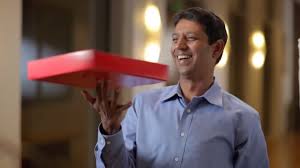
This is Kickbox, the employee innovation program developed by Mark Randall, Adobe’s VP of Creativity. Since its inception last year, the Kickbox program has been a huge hit within the company, involving over 1,000 international participants who have received their shiny red boxes and used them to manifest all kinds of creative projects, apps, and Adobe product enhancements that might otherwise have never seen the light of day.
When we learned that Mark would be speaking at this week’s Lean Startup Conference in San Francisco, we leapt at the chance to speak with him about Kickbox and his insights so far.
Q: Mark, could you give us an overview of how the KickBox process works?
Mark Randall: Kickbox is an innovation process that comes packaged in a box, and inside is everything an innovator will need to come up with an interesting idea—or, ideally, a bunch of them—and then evaluate those ideas to narrow in on one that they’d like to investigate, develop, and try to actualize.
They then pursue their idea by assessing it through a variety of lenses and testing it with customers, asking: Would my proposed solution solve problem X if we were to build it? They then use this customer engagement data to justify support from management to pursue the concept further.
Q: How does Adobe fund and manage hundreds of innovation projects at once?
MR: It starts with trusting our people. In Kickbox, innovators manage themselves in the seed phase. They are the CEO of their idea. They decide where to focus their time and invest their resources. This makes Kickbox not only highly scalable but empowering. Kickbox includes a process with six color-coded levels that guide innovators through the adventure of creating something bold and new. The process is self-gating because each level has a checklist which must be completed to advance to the next level. Upon completing Level 6 innovators have beaten the red box, which earns them funding to pursue their idea further as well as a magical prize…a blue box.
Q: How did you come up with this out-of-the-box idea?
MR: I’d been working on some new product explorations at Adobe, where small teams were employing lean, agile techniques to be more innovative and better anticipate customers’ needs. Some people asked if there was a way I could show other employees how to use these methods throughout the company, because it seemed to be so effective.
I went away and thought about it, but I wasn’t sure how to train others to approach product creation in the way I’d been doing it with my own product concepts. I received encouragement from colleagues, suggesting that I look at “coloring outside the lines” if necessary. That’s when it clicked for me. I realized we should approach equipping and empowering innovators the same way we approach solving our external customers’ problems.
As soon as I reframed the problem to think of potential innovators inside Adobe as my “customers,” the solution started to come into focus. We could create a “product” called Kickbox that would equip innovators to create their own products in a lean and agile way. That’s how it became an actual packaged box.
Interestingly, this way of reframing a problem to reveal a non-obvious solution is one of the techniques Kickbox teaches innovators. In a sense, the Kickbox program itself was conceived, validated, and iterated using Kickbox methods.
Q: So you designed a physical product to make the abstract concept of innovation more concrete and actionable?
MR: Right. The challenge was, “Find a way to unleash more innovation,” and it became clear that a high-leverage way to do that would be to focus on creating more innovators rather than just more innovations. The Kickbox program gives employees who may not be in product development or design roles hands-on experience engaging with customers to invent and validate new solutions. Whether their first project succeeds is less important than the experience and skills gained. This is about investing in our people to build a uniquely valuable competency that will pay dividends for years.
Q: What’s the ultimate benefit of participating in a program like this?
MR: Just going through it gives employees an incredible amount of experience—they know how to come up with a valuable idea, express it concisely, evaluate it internally, validate it externally with customers, and then use that real-world data to build support in the company to pursue the idea. Cultivating that skill set is enormously valuable both for that individual and for the company.
Q: What kind of feedback have you received from your KickBoxers?
MR: People really seem to love it, and it has a big impact on them. They’re no longer just employees performing their assigned tasks. They’re now innovators able to align their personal passion for invention with the company’s purpose of solving hard problems for our customers. And whether they’re applying their new skills to existing projects or creating new projects, we’ve awakened a sense of personal initiative to imagine, to dream, and to create, which has always been the core of Adobe’s DNA. Kickbox is helping us achieve our goal of being an 11,000-person company where every employee has that DNA and can express it every day.
